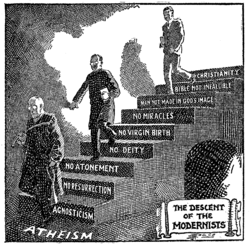Holiness movement
The holiness movement is about certain of beliefs and practices that came from Methodism in the 19th-century. It also refers to some groups of evangelical Christianity who believe that these ideas are central doctrine. The movement is distinguished by its focus on John Wesley's teaching of "Christian perfection" . It says that it is possible to live free of sin, and specifically by the belief that this can be done instantly by preforming a second work of grace.
Holiness Movement Media
Henry Clay Morrison, a Methodist evangelist and founder of Asbury Theological Seminary
Julia A. J. Foote, an elder in the African Methodist Episcopal Zion Church, preached Christian holiness in the pulpits of her connexion. Her autobiography has the theme of entire sanctifiation interwoven in it and concludes with "How to Obtain Sanctification".
An illustration from The Circuit Rider: A Tale of the Heroic Age by Edward Eggleston depicting a Methodist circuit rider on horseback, 1906
A Fundamentalist cartoon portraying Modernism as the descent from Christianity to atheism, first published in 1922 and then used in Seven Questions in Dispute by William Jennings Bryan
A Salvation Army band parade in Oxford, United Kingdom
Other websites
- How They Entered Canaan: A collection of holiness experience accounts Archived 2016-03-08 at the Wayback Machine by B. G. Paddock
- Holiness history from the Global Anabaptist Mennonite Encyclopedia Online
- A Look At Holiness And Perfectionism Theology Archived 2010-07-07 at the Wayback Machine by Armin J. Panning





